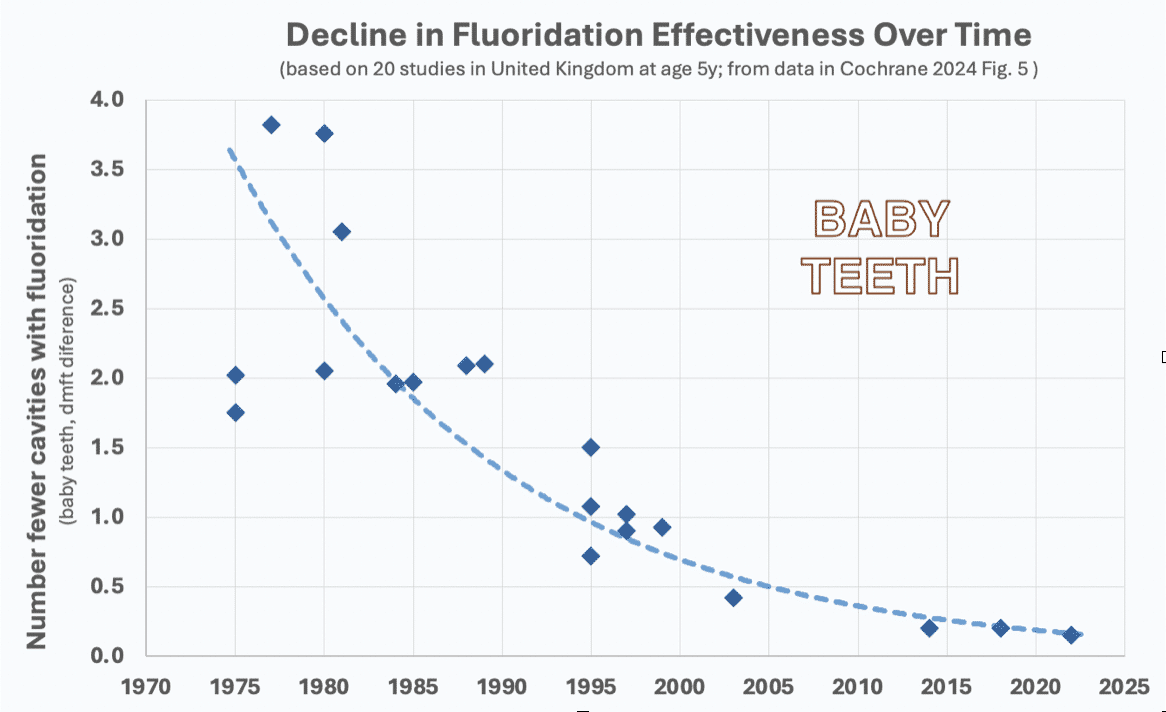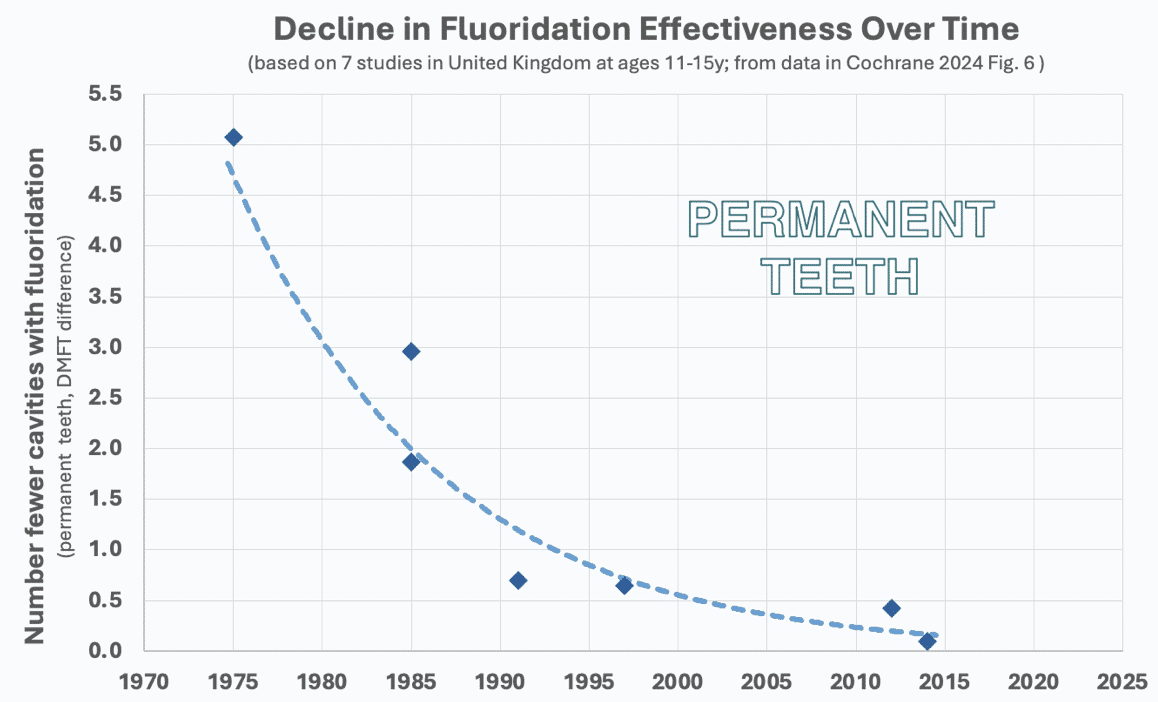
Another Blockbuster Fluoridation Report: No Longer Any Significant Reduction of Cavities
by Fluoride Action Network | Oct 7, 2024
• Fluoridation’s effectiveness has declined to almost nothing over the past 50 years
• Authoritative review finds less than 4% reduction in tooth decay
• Only about “one quarter of a tooth” reduction
• Stopping fluoridation is now a “No Brainer”: Confirmed risk of lowering child IQ and no significant benefit to teeth. What’s the point?
The Cochrane Collaboration – highly respected for its independent reviews of health interventions – released its updated assessment of Water fluoridation for the prevention of dental caries yesterday. After a thorough search and review of available studies, it concluded contemporary evidence doesn’t show a reduction in cavities of more than 4%, and there may be no benefit at all. The report said the average benefit was only about “one quarter of a tooth,” which is one cavity in every four children. The review found a large decline in fluoridation effectiveness over the past 50 years. While 1970s studies showed young children in fluoridated areas may have saved as many as 4 cavities in their baby teeth, the most recent study from 2022 found a reduction of only 0.16 decayed teeth. This represents a 25-fold decline in fluoridation effectiveness to an amount so small as to be of questionable clinical or public health value, and likely a net economic loss rather than benefit.
The Cochrane report’s main conclusions were:
“Adding fluoride to water may slightly increase the number of children who have no tooth decay in either their baby teeth or permanent teeth. However, these results also included the possibility of little or no difference in tooth decay.”
“We could not be sure whether adding fluoride to water reduced tooth decay in children’s permanent teeth.”
“We were unsure whether there were any effects on tooth decay when fluoride is removed from a water supply.”
“We were unsure if fluoride reduces differences in tooth decay between richer and poorer people.”
The report identified only 22 studies of acceptable quality in children, and none in adults, highlighting the paucity of high-quality studies of fluoridation effectiveness despite claims by fluoridation promoters that there are thousands of studies, and that its effectiveness has been proven.
The Cochrane review’s literature search cutoff was in 2023, so it did not consider the LOTUS study of over 6 million adults in England, published in January 2024. The LOTUS study was the largest, strongest study of fluoridation effectiveness in adults ever done and found virtually no benefit: a lifetime reduction in decay of only 2%. The LOTUS study authors concluded:
“This study suggests that exposure to optimal water fluoridation between 2010 and 2020 resulted in ‘exceedingly small’ health effects, ‘very small’ reductions in NHS dental service utilization, and no meaningful reduction in social inequalities.” [Moore 2024, p. 7]
An accompanying economic analysis for the LOTUS study found the meager dental bill savings would be worth only about $1 a year per person; not enough to buy a single cup of coffee. Furthermore, the analysis did not consider the capital costs of new fluoridation schemes, let alone the cost of adverse effects like reduced IQ and dental fluorosis.
Fluoridation effectiveness: 50-year decline to almost nothing
The large decline in fluoridation’s effectiveness over the past 50 years found in the Cochrane review is illustrated by two graphs created by FAN’s Science Director, Chris Neurath, from the report’s data. The first graph is for deciduous (baby) teeth, and the second for permanent teeth:


Although studies from the 1970s found reductions of up to 5 cavities per child, that benefit has declined rapidly, and the most recent study finds fluoridation providing a reduction of only 0.16 carious teeth. That latest study was by Public Health England, which ironically is the same government agency trying to expand fluoridation to all of England.
The Cochrane report described their findings on declining effectiveness (p. 32):
“Data from these UK single time point studies, alongside the results of the review, show a clear reduction in the size of effect with regard to caries measures over time (Figure 5), with the most recent single time point studies showing a mean difference of 0.16 to 0.21 dmft between fluoridated and low-fluoridated/non-fluoridate areas.”
Co-author of the Cochrane review, Dr. Lucy O’Malley PhD, using typical academic understatement, advised:
“Given that the benefit has reduced over time, before introducing a new fluoridation scheme, careful thought needs to be given to costs, acceptability, feasibility, and ongoing monitoring.”
Fluoridation economic cost-benefit: it’s always a loser
On the issue of costs, UK activist David Forrest CEng analyzed the net economic costs/benefits based on a detailed UK Department of Health (DHSC) assessment of costs for a large new fluoridation scheme in northeast England. Forrest found that even DHSC’s optimistic cost-benefit analysis concluded that over the next 40 years, the claimed savings from fewer cavities would barely break even against the capital and operating costs of the fluoridation scheme (DHSC report p. 22), which would amount to almost $800 million. The DHSC’s optimistic assumption was that fluoridation would reduce decay in permanent teeth of all ages by 12%. Forrest points out that with the LOTUS study finding only a 2% reduction in adults and the Cochrane review now finding children have only a 3% reduction in permanent tooth caries, any new fluoridation program would be economic folly and a waste of taxpayer money.
The Cochrane review has found fluoridation’s effectiveness has declined to a level where it would cost much more to add fluoridation chemicals to water than could be offset by cost savings from filling slightly fewer cavities.
Highest quality recent study finds fluoridation ineffective against rampant childhood caries, “baby bottle tooth decay”
One of the last defenses claimed by fluoridation advocates is that the Cochrane review did not look at the most serious cases of tooth decay in young children, which can lead to hospitalization and general anesthesia for treatment. They show photos of mouths filled with horribly decayed teeth as a scare tactic and claim fluoridation can reduce these cases. While the Cochrane review did not evaluate this, it did score the recent CATFISH study (Goodwin 2022) as the highest quality of any studies of fluoridation and decay in young children. CATFISH evaluated rates of general anesthesia for dental extractions and concluded there was no significant difference between fluoridated and non-fluoridated [Goodwin 2022, p. 53].
No longer any reason for fluoridation
Leading fluoridation-promoting organizations like the American Dental Association (ADA) have dismissed the two other recent blockbuster findings, 1) that fluoride can reduce child IQ as determined by the National Toxicology Program, and 2) the US federal court decision that artificial fluoridation poses an unreasonable risk of reducing IQ in children. The ADA continues to claim fluoridation is “safe and effective,” the same refrain they’ve asserted for over 50 years. Hopefully, with the release of the Cochrane review finding fluoridation’s effectiveness has waned to almost nothing, responsible dentists and public health officials will accept that there is no longer a scientific or logical rationale for continuing to promote fluoridation.
FAN’s Research Director, Chris Neurath, commented on the implications of the Cochrane report, “This new evidence allows fluoridation defenders to bow out gracefully. Fluoridation did appear to be effective in the early years, and most of the strongest evidence that it poses a real risk of lowering children’s IQ has emerged in just the past 5 to 10 years. So, fluoridation promoters can honestly say that the science on effectiveness and safety has changed.”
FAN’s Executive Director, Stuart Cooper said, “This Cochrane report, together with the recently released federal court ruling and NTP reporting findings of child IQ loss, means the time is over for fluoridation. It’s been 80 years since the first demonstration trial of fluoridation was proposed at the close of WWII. The scientific evidence has advanced far beyond what was known back then. It’s time for citizens to ask their local officials to look beyond the outdated mantra of ‘safe and effective’.”
Subscribe to The Fluoride Action Network





